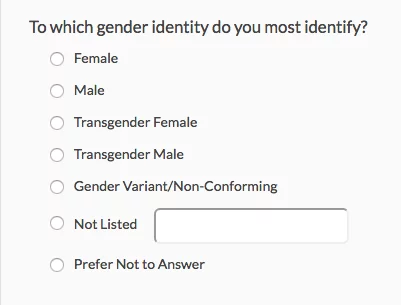
Conducting research with an online survey platform like Alchemer gives you easier access to more people, but it requires asking demographic survey questions to understand the data. Sometimes you don’t need this data, other times it contributes a lot to the richness of your findings.
When it comes to demographic survey data, gender and age are two of the most commonly asked questions.These basics are genuinely useful for analysts to slice and dice information.
But the days of giving respondents only “Male” or “Female” as their gender options in surveys have long passed. Even if you’re not asking demographic survey questions for college students.
The challenge for current users of online survey software is to balance the need to collect actionable data with the importance of creating an inclusive range of gender choices. And do it all without risking survey fatigue.
We’re going to take a look at two extremes on this spectrum — basic binary gender options and a survey with 25 gender choices — so we can ultimately identify a gender choice question that provides useful data while being respectful of respondents.
Extreme #1: Too Many Gender Options
In January of 2016, The Sun reported that the Department of Education distributed a Government-backed survey to teenagers in the United Kingdom, offering a list of 25 gender options.
In a rebuttal of the survey and its larger goals, the Associate Editor of The Spectator, Toby Young, provided this full list of the options:
1. Girl
2. Boy
3. Tomboy
4. Female
5. Male
6. Young woman
7. Young man
8. Trans-girl – Someone who has or is currently transitioning from male to female.
9. Trans-boy – Someone who has or is currently transitioning from female to male.
10. Gender fluid – Those who have different gender identities at different times.
11. Agender – Those with no gender identity or a neutral identity.
12. Androgynous – Partly male and female. Not one specific sex.
13. Bi-gender – Those who experience two gender identities, either at the same time or swapping between the two. These can be male and female or other identities.
14. Non-binary – A blanket term to describe those who do not feel exclusively male or female.
15. Demi-boy – Someone whose identity is only partly male, regardless of their birth gender. They may or may not also identify as another gender.
16. Demi-girl – Someone whose identity is only partly female, regardless of their birth gender. They may or may not also identify as another gender.
17. Genderqueer – Those who don’t go along with traditional gender distinctions.
18. Gender nonconforming – Those who do not follow conventional ideas about how they should look or act based on their birth gender.
19. Tri-gender – Shifts between three genders, which could include male,
female and genderless or another combination.
20. All genders – Someone who identifies as every possible gender option.
21. In the middle of boy and girl – An individual who identifies somewhere in between male and female.
22. Intersex – Someone with physical, genetic and hormonal features of a male and female.
23. Not sure
24. Rather not say
25. Others (please state)
Inclusivity is vitally important, but survey best practices dictate that we also need to avoid fatiguing the people taking our surveys. Certainly, a massive list of answer options like this one falls under the category of “highly fatiguing” questions.
Of course, the other extreme is not any better.
Extreme #2: Male or Female. Period.
If the broader argument for inclusivity doesn’t move you, consider that limiting your gender choices to the traditional binary may also have a negative impact on your survey’s data.
Stanford sociologist Aliya Saperstein reminds us that, “If the world is changing and [surveyors] are not changing the measures, it’s not clear that we’re getting the information we think we’re getting, even if we ask the same questions we always have.”
Sociology professor Laural Westbrook agrees: “We have been taking gender categories for granted for too long. It doesn’t help us better understand health disparities or income gaps or voting patterns to always divide the population into he’s and she’s.”
Clearly, continuing to ask the same questions the same way in perpetuity in the name of longitudinal research is not a useful way to maintain data integrity. Nonetheless, this problem persists throughout the survey, research, and feedback worlds – from government forms to SparkPeople.com surveys.
A.J. Walkley recently reported on the Huffington Post that a poll of fellow activists revealed a stunning lack of options in survey questions: “I was overwhelmed by stories of the lack of inclusion on forms they’ve been given to fill out from various institutions, including LGBT+ groups themselves.”
We can do better, and making your survey questions inclusive doesn’t have to destroy your data either.
Suggestions for More Inclusive Gender Survey Questions
There are really two parts to creating a positive experience around asking respondents to provide gender survey data:
- Determine why you’re asking about gender in the first place. If it’s not a crucial part of your data analysis plan, you may be able to eliminate the question altogether.
- If you do decide to ask about gender, craft the question carefully. Be sure you don’t conflate biological sex and gender, and create a question that allows respondents to answer honestly and comfortably. We’ll give you some examples to help you get started.
When to Ask About Gender in Surveys
The Center for Diversity & Inclusion at American University suggests spending some time in introspection before asking about gender in a survey. The Human Rights Campaign echoes this sentiment, particularly when it comes to employers collecting demographic data about employees with employee satisfaction surveys and employee engagement surveys.
Consider these questions:
- Why is the survey collecting information around gender, sex, and/or sexual orientation?
- How will the information be used?
- Will the data be broken down by category or used for cross-tabulation?
- What is the business rationale for asking about gender on this particular form?
- How will the data be used, protected, or reported? What legal restrictions might there be on the collection or storage of demographic data, in the U.S. or globally?
American University reminds survey creators that, “Often the questions are asked because we feel like they should be asked, or because we consider them ‘standard’ demographic questions, not because the data are necessary for cross-tabulation.”
If you decide gender will be an important data point for your survey, make sure you follow these guidelines when designing the question.
Best Practices for Collecting Gender Data in Surveys
First and foremost, make sure you keep questions about sex, gender, and sexual orientation separate. This doesn’t mean that you need to collect data about all three, only that you make sure your questions address the category you’re actually interesting in.
These distinctions from American University’s Center for Diversity & Inclusion offer a useful guide:
Sex refers to the biological make up in terms of chromosomes, hormones, and primary and secondary sex characteristics. When asking about sex as a category, words like male, female and intersex should be used.
Gender identity refers to the internal/psychological sense of self, regardless of what sex a person was assigned at birth. When asking about gender as a category, words like woman, man, and trans* should be used.
Sexual orientation refers to a person’s emotional, physical, and sexual attraction to other people. When asking about sexual orientation as a category, words like gay/lesbian, bisexual/pansexual, and heterosexual should be used. Please note that homosexual is not recommended as it is often used in a pejorative tone.
Sample Gender Questions
These are some of the best options for collecting gender-related data. When choosing the one that’s right for you, keep your data analysis goals and respondents’ situations in mind. Remember, you want to balance your own need for information with the personal feelings of the people taking your survey.
Completely Open Ended Question:
Gender? ___________
You’ll have to do some open text analysis on these responses, but it makes it very easy for people to choose their own category.
Options for Cross Tabulation
If you know you need this data in set categories to aid in data analysis, you can still create respectful categories without overwhelming respondents.
We suggest a radio button question like this (although what works for your particular audience may differ slightly):

Note that the best way to phrase this question is something like, “To which gender identity do you most identify?” rather than simply, “Gender.”
The Importance of Gender Questions in Surveys
In their 2015 study, “New Categories Are Not Enough: Rethinking the Measurement of Sex and Gender in Social Surveys,” Saperstein and Westbrook drive home the importance of thinking critically about the way we ask about gender in our surveys:
“A hyper-gendered world of ‘males’ and ‘females,’ ‘brothers’ and ‘sisters,’ and ‘husbands’ and ‘wives’ shapes what we can see in survey data. If not altered, surveys will continue to reproduce statistical representations that erase important dimensions of variation and likely limit understanding of the processes that perpetuate social inequality.”
So please, choose your survey questions (and response options) wisely.




